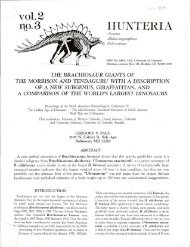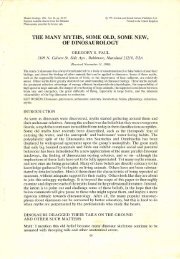THE SEGNOSAURIAN DINOSAURS: RELICS OF ... - Gregory S. Paul
THE SEGNOSAURIAN DINOSAURS: RELICS OF ... - Gregory S. Paul
THE SEGNOSAURIAN DINOSAURS: RELICS OF ... - Gregory S. Paul
You also want an ePaper? Increase the reach of your titles
YUMPU automatically turns print PDFs into web optimized ePapers that Google loves.
almost all theropods. All thecodonts differ from segnosaurs<br />
in having shorter, broader, separate vomers,<br />
and larger, more heavily built pterygoids (Fig. 3).<br />
Braincase-Erlikosaurus has an unusual braincase<br />
in that the basisphenoid is grossly expanded into an<br />
intensely pneumatized bulbous structure (Perle, 1981).<br />
However, the occipital face is that of a herbivorous<br />
dinosaur in appearance-low, with small posterior parietals,<br />
a dorsally placed supraoccipital, elongated, narrow<br />
opisthotic wings,and, as in omithischians, a closed<br />
post-temporal fenestra (Fig. 3). Theropods also have<br />
the latter character, but have none of the other features<br />
(Fig. 3).Most thecodonts have taller occiputs with large<br />
parietals, a lower supraoccipital, shorter, broader opisthotic<br />
wings, and a large post-temporal fenestra (Fig.<br />
3). Erlikosaurus has a fenestra pseudorotunda, a middle<br />
ear structure also found in prosauropods and theropods<br />
(<strong>Paul</strong> and Carpenter, in preparation), omithischians<br />
(Perle, 1981;Sues, 1980;Brett-Surman and <strong>Paul</strong>,<br />
in press), and phytosaurs (Camp, 1930). This contradicts<br />
assertions that dinosaurs and thecodonts lacked<br />
this structure (Whetstone and Martin, 1979, 1981).<br />
Teeth - Those arguingfor dinosaur monophyly have<br />
stressed the similarity of the distinctive, constrictedwaisted<br />
and expanded-crowned teeth of prosauropods<br />
and early omithischians (Bakker and Galton, 1974;<br />
Bonaparte, 1976). Erlikosaurus, too, has this type of<br />
tooth (Barsbold and Perle, 1979; Perle, 1979, 1981).<br />
Among the thecodonts onlyaetosaurs have similar teeth<br />
(Walker, 1961). Theropods and most thecodonts are<br />
very different in having blade-crowned, straight-rooted<br />
teeth.<br />
Postcrania-Segnosaurs are typically dinosaurian in<br />
skeletal morphology, short-trunked, with long, fully<br />
erect, cylindrically jointed limbs. This is completely<br />
different from thecodonts which are long-trunked, lowslunganimals<br />
with semierect, complexlyjointed limbs.<br />
Forelimb-Like the pes, the segnosaurian forelimb<br />
with its semicircular scapulocoracoid, down and backwards<br />
facing glenoid, and a large, rectangular, deltopectoral<br />
crest represents a basal dinosaurian grade that<br />
otherwise is found in lagosuchids,early theropods, prosauropods,<br />
and Heterodontosaurus (Fig. 4), but not in<br />
thecodonts. This forelimb design grade is also found<br />
in the Late Cretaceous Therizinosaurus (Barsbold,<br />
1975), a Mongolian specimen of unknown affinities,<br />
and a humerus assigned-perhaps incorrectly-to the<br />
Late Cretaceous Mongolian tyrannosaurid Alectrosaurus<br />
(Gilmore, 1933; Perle, 1977).<br />
Pelvis and Hindlimb-The segnosaur pelves blend<br />
omithischian, sauropod, and unique characters into a<br />
very unusual design. The pubis is retroverted and lacks<br />
an anterior process (Fig. 4). The ilia are sauropod-like<br />
in having a very deep, laterally flaring anterior blade<br />
(Perle, 1979). This probably represents convergence<br />
with sauropods in order to support a massive, fermenting<br />
gut for processing ingested fodder. The retroverted<br />
pubis is of course the omithischian condition<br />
and may be expected in a proto-omithischian (Fig. 4).<br />
But retroverted pubes are also seen in the basal di-<br />
JVP 4(4), December 1984<br />
~~~<br />
III<br />
~ii)iE~_<br />
eorly theropod prosocrcood oojttischion theropod<br />
FIGURE 4. The left scapulocoracoid and humerus (top<br />
row), pelvis in left lateral view (second row), the left articulated<br />
tibia, fibula, astragalus, and calcaneum in anterior<br />
view (third row) and in distal view (fourth row, astragalus<br />
hatched, calcaneum removed) of various dinosaurs compared<br />
to segnosaurs. In part after Huene (1907), Lambe (1917),<br />
Raath (1969), Galton (1974), Barsbold (1979), Perle (1979,<br />
1981), Barsbold and Perle (1979, 1980), Santa Luca (1980),<br />
and Cooper (1980, 1981).<br />
nosaur Herrerasaurus (unbroken MCZ uncataloged<br />
specimen), the sauropod Nanshiungosaurus (Dong,<br />
1979), velociraptorids and other derived theropods<br />
closeto bird ancestry (Barsbold, 1979),Archaeopteryx,<br />
and in birds themselves. No thecodont had a retroverted<br />
pubis.<br />
It is important to note that the retroverted pubis of<br />
segnosaurs is significantly closer to those of omithischians<br />
than to those of the bird-like theropods and<br />
birds. In the protobird-bird clade the pubic peduncle<br />
ofthe ilium is retroverted in the same direction as the<br />
pubis (Barsbold, 1979). In segnosaurs and omithischians<br />
the pubic peduncle is not retroverted in the<br />
same line as the pubis; instead it points forwards (Fig.<br />
4). H errerasaurus also has the latter kind of pubic peduncle;<br />
in fact, a forward pointing pubic peduncle is<br />
the general archosaur condition.<br />
The Segnosaurus ankle is both interesting and perplexing.<br />
It is omithischian-like in having a deep lateral<br />
malleolus of the tibia that backs the fibula distally,<br />
reduced astragalar condyles that only partly cover the<br />
distal tibia, and a tall triangular ascending process (Fig.<br />
511









